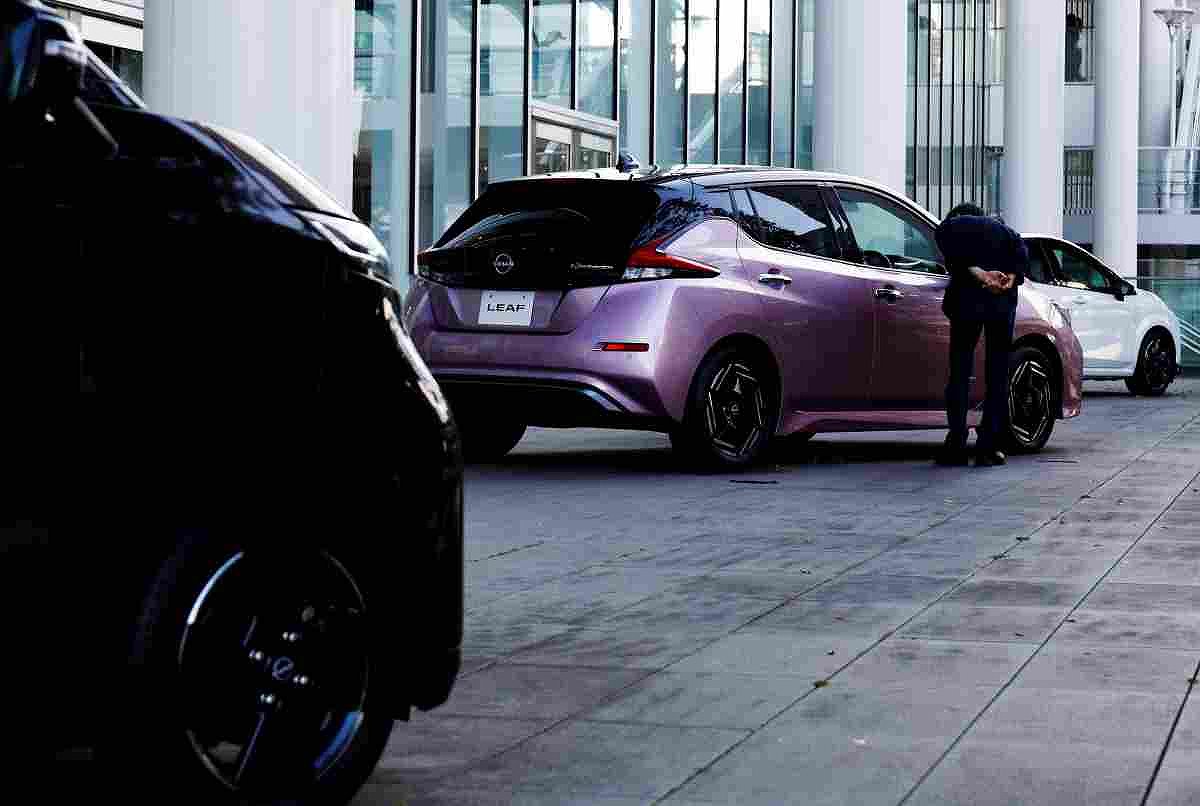Japan EV Subsidy Program to Evaluate Measures by Manufacturers; Charging Point Numbers, Response to Issues to Impact Subsidies

A visitor looks at Nissan Motor’s electric vehicle (EV) model Leaf at its showroom in Yokohama on Nov. 3.
21:00 JST, November 24, 2023
The government plans to review its criteria for the calculation of subsidies for people buying electric vehicles (EVs) and other eco-friendly vehicles, it has been learned. Measures taken by manufacturers, such as increasing the number of EV charging points and enhancing responses to vehicle failures, will be added to the list of evaluation items for the subsidy program in fiscal 2024.
The government aims to boost the entire industry by encouraging manufacturers to address factors that prevent the spread of EVs.
Under the government’s subsidy program for promoting the introduction of clean energy vehicles, the amount of money provided as a subsidy is calculated based on the type, performance and functions of the eco-friendly vehicle. Under the new criteria, it is possible that the subsidies will differ between manufacturers, even among vehicles of the same type. This means that measures taken by manufacturers will be directly linked to the competitiveness of their products. The government will decide the details of the new criteria in the future, such as the maximum amount available as a subsidy per vehicle.
Currently, a subsidy of up to ¥650,000 is provided to purchase an EV, which can be increased up to ¥850,000 based on the travel distance per charge, the electricity mileage (equivalent to gasoline mileage), the presence of an external power supply function and other factors.
From fiscal 2024, the government will add other evaluation items such as the number of charging points installed at dealers of respective manufacturers and their ability to respond to repair and maintenance needs. The government will also take into account whether manufacturers have signed agreements with municipalities to dispatch electrified vehicles to them in the event of natural disasters and whether they are making efforts to collect used batteries from vehicles.
The government aims to reduce greenhouse gas emissions to net zero by 2050 and has set a goal for electrified vehicles, such as EVs and hybrid vehicles (HVs), to make up 100% of new car sales by 2035.
In fiscal 2022, the domestic sales of EVs totaled 77,000 units — only 2% of total passenger car sales. It has been said that the reason for the low sales is that many people are concerned about the low number of charging points and the quality of responses to vehicle failures, in addition to the high prices of the vehicles.
The government is very concerned that an increase in the number of cheap, low-quality EVs could undermine trust in the entire industry. By creating new criteria, the government hopes to encourage manufacturers to develop an environment for the promotion of EVs and to support the growth of the industry as a whole.
In other countries, more and more governments are adopting policies to encourage the purchase of domestically produced EVs. For example, the U.S. government provides preferential measures for EVs assembled in North America.
Giving either preferential or discriminatory treatment to products from specific countries or regions could violate the rules of the World Trade Organization. The Japanese government will share a draft for the new criteria with Western and other countries, which could help establish an environment for the promotion of EVs and other eco-friendly vehicles.
"Politics" POPULAR ARTICLE
-

Japan to Support Central Asian Logistics Route That Bypasses Russia, Plan to Be Part of Upcoming Summit in Tokyo
-

Japan to Tighten Screening of Foreigners’ Residential Status by Providing Information of Nonpayment of Taxes
-

Chinese, Russian Bombers Flew Unusual Path by Heading Toward Tokyo; Move Likely Meant to Intimidate Japan
-

Japan Plans National Database to Track Foreign Ownership of Real Estate, Land as It Weighs New Rules
-

Up to 199,000 Deaths Estimated From Mega-Tsunami; Most Recent Occurrence Took Place in 17th Century
JN ACCESS RANKING
-

Tokyo Economic Security Forum to Hold Inaugural Meeting Amid Tense Global Environment
-

Keidanren Chairman Yoshinobu Tsutsui Visits Kashiwazaki-Kariwa Nuclear Power Plant; Inspects New Emergency Safety System
-

Imports of Rare Earths from China Facing Delays, May Be Caused by Deterioration of Japan-China Relations
-

University of Tokyo Professor Discusses Japanese Economic Security in Interview Ahead of Forum
-

Japan Pulls out of Vietnam Nuclear Project, Complicating Hanoi’s Power Plans























